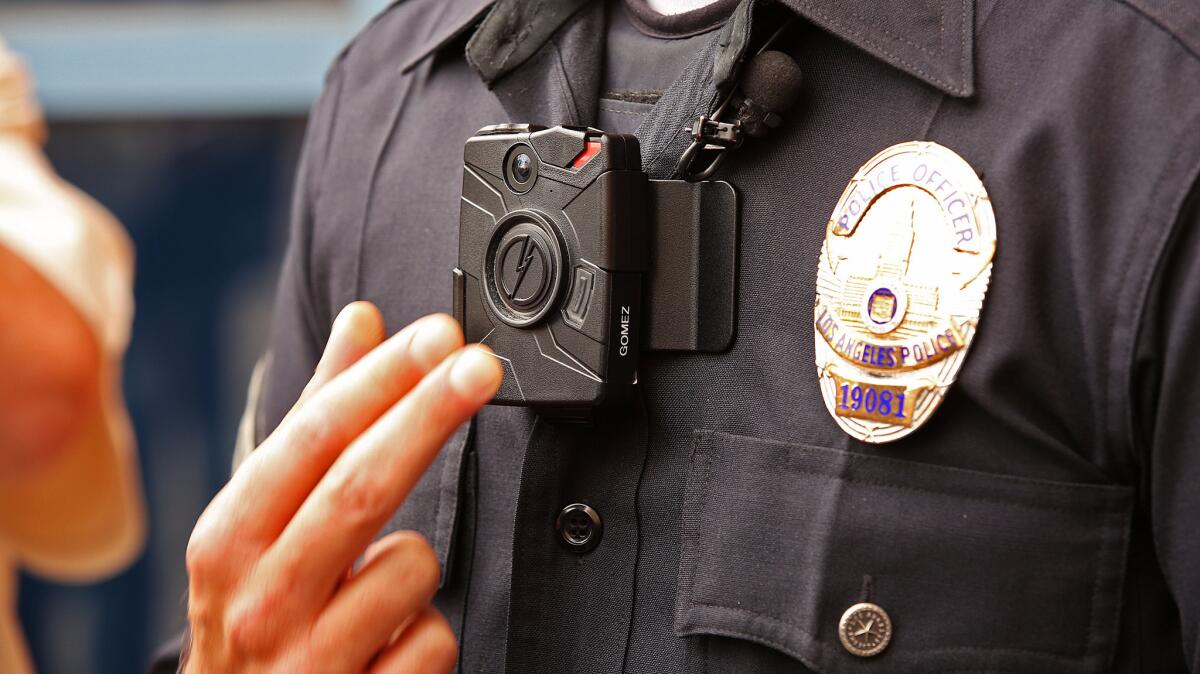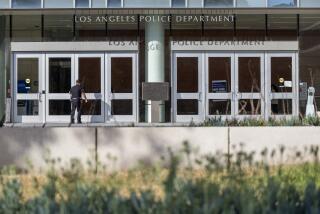How transparent will the LAPD be on releasing videos of police shootings, other controversial encounters?

- Share via
For more than a year, the plan to put body cameras on thousands of Los Angeles police officers has been clouded by a divisive debate over a key question: How much video should be made public and when?
The LAPD insisted it would generally withhold the recordings unless required to provide them by a court. Chief Charlie Beck said he considered the video to be evidence that is exempt from public disclosure laws, stressing the need to protect the integrity of investigations and the privacy of victims.
But civil liberties groups, local activists and at least one police commissioner criticized the stance, saying withholding the footage undermines the accountability and transparency body cameras are supposed to bring to policing.
This week, amid heightened scrutiny over police shootings across the country, the issue took on new life when the president of the L.A. Police Commission said it was time to reconsider the LAPD’s stance. In addition, Beck said he would be open to releasing certain footage “at the proper time in the proper framework” and that LAPD officials have been closely monitoring a new approach taken by San Diego authorities.
Once you open that Pandora’s box, who’s going to decide what’s going to be released?
— Craig Lally, Police Protective League president
There, officials have recently started to release “relevant portions” of body camera footage from police shootings once the district attorney decided not to charge the officers involved. If charges are filed, however, the recordings would be considered evidence and withheld until they were made public at trial.
Supporters of broader access to police video welcomed a review of the LAPD’s policy. An attorney with the American Civil Liberties Union called it “long overdue.” But, he added, officials would need to craft specific guidelines preventing the LAPD from sharing only footage that helped officers.
“They can’t just leave it to their discretion to release video if it exonerates officers and withhold it if it’s incriminating,” said Peter Bibring, a senior staff attorney for the ACLU of Southern California.
But the president of the union that represents rank-and-file LAPD officers sharply rejected the idea of releasing any of the recordings. Craig Lally said he feared the decision to release certain footage would be influenced by public or political pressure, jeopardizing evidence that could be used in a trial.
“Once you open that Pandora’s box, who’s going to decide what’s going to be released?” Lally said. “Is it going to be the chief of police? Is it going to be the mayor? What’s the criteria going to be?
“You can’t go down that road,” Lally added.
The LAPD has seen protests over several shootings by officers in recent years, including a deadly 2015 confrontation on skid row that was captured by body cameras.
Police say officers opened fire on Charly Keunang after he reached for a rookie officer’s holstered gun during a struggle. A bystander posted a dramatic video of the shooting online, drawing millions of views and putting international attention on the LAPD.
The district attorney’s office is still reviewing whether to charge the officers who fatally shot Keunang. The footage from their body cameras has not been made public.
Across the country, law enforcement officials are having similar debates as more agencies embrace body cameras as a way to improve public trust in policing. Many agencies have resisted the idea of releasing footage. Last week, North Carolina prohibited police agencies from releasing videos captured by cameras in patrol cars or on officer uniforms without a court order.
But at a time when bystander cell phone videos showing shootings by officers can spark a firestorm of criticism, departments elsewhere are facing increasing pressure to make their own recordings public.
That scenario played out this week in Fresno, where police released graphic recordings of officers shooting an unarmed 19-year-old whose death had led to anti-police protests and allegations that the officers used excessive force. Fueling the criticism was a bystander’s cell phone video that showed the final two shots fired, when the man was laying in the road.
The footage from the body cameras, however, showed more of the June 25 traffic stop that ended with Dylan Noble’s death. The recordings revealed that Noble repeatedly ignored commands from officers, instead walking toward them with something — later determined to be a plastic container with clay — in his hand.
The decision by Fresno police to share the recordings publicly has been widely discussed by law enforcement officials and others paying close attention to the issue. California lawmakers have yet to approve legislation on the issue, leaving individual agencies to decide for themselves if or when to release footage.
In Los Angeles, the president of the civilian board that oversees the LAPD said he wants to reconsider the department’s policy against releasing police videos. The department is in the midst of purchasing and rolling out body cameras to about 7,000 officers and is finishing a department-wide initiative to install dashboard cameras in patrol cars.
Police Commission President Matt Johnson said in a statement that the panel plans to review how other departments are handling what footage to release.
“Our video release policy was never written in stone, and I believe now is a good time to revisit it,” Johnson said.
Any change in the LAPD’s policy, he said, needed to comply with state law and avoid interfering with reviews by the district attorney’s office of police shootings and other controversial incidents.
“Video, while an important piece of evidence, does not tell the entire story,” Johnson said. “I want to make sure that when video is released, it is done within a framework of releasing other evidence that helps complete the picture.”
At least one other member of the five-person panel supported revisiting the rules, and a third said he wanted to hear whether Beck had reconsidered his views.
Beck said he has discussed the issue with police commissioners, the mayor and district attorney. There are still privacy concerns, particularly for crime victims, he said. And he doesn’t want the public release of video to interfere with criminal or administrative investigations.
“But I’m not opposed to coming up with a way where we can satisfy more concerns here,” he told The Times.
Robert Saltzman, a commissioner who expressed concerns about the LAPD policy when it was crafted, said that he agreed it was time to revisit the issue. A “blanket refusal” to release video undermines the attempts to build public trust by having the body cameras, he said.
“I continue to think that it’s very important that we have a much more liberal policy regarding releasing the video,” he said. “Not releasing the video should be the exception, not the rule.”
Steve Soboroff, another police commissioner and longtime advocate for the body cameras, noted that when the LAPD’s policy was crafted last year, the chief said there may be circumstances in which he would consider releasing the footage. Now that the LAPD — along with other agencies — have more experience with the cameras, Soboroff said he was interested in hearing the chief’s definition of what those circumstances may be.
“What are the circumstances under which release is appropriate, and is it broader now that we’ve had a year now see how it’s working? Or is it the same?” Soboroff said.
Though the LAPD is poised to become the largest law enforcement agency in the country to use body cameras on a widespread scale, it’s not the only L.A. County department to roll out the technology. The Sheriff’s Department also plans to equip deputies with the devices. While no policy is in place, a spokesman said the sheriff was “committed to being transparent” and plans to release videos when legally allowed.
Dist. Atty. Jackie Lacey said her office is paying “very, very close attention” to the policies that different agencies are using for body cameras across L.A. County. Lacey told The Times that she was concerned that releasing recordings before her office has decided whether to file charges in a case could taint not only potential jurors, but witnesses. After that, she said, it’s up to the agency involved to decide what to do with the video.
“Once the case is over with and once we’ve made a decision … that’s going to be their call,” she said.
But Bibring, the ACLU attorney, expressed concern about waiting until prosecutors were done. In Los Angeles County, the district attorney’s office typically doesn’t decide whether to file charges against an officer until several months — sometimes more than a year — after a deadly force incident.
“When a community has been subjected to a police shooting,” he said, “they want answers in a matter of days — not years.”
For more LAPD news, follow me on Twitter: @katemather
Click here for a Spanish version of this story
ALSO
14 people wounded in shooting at Bakersfield house party
Flights between L.A. and Istanbul canceled amid Turkish unrest
Suspect in attacks on homeless men in San Diego has history of arrests and mental issues
More to Read
Sign up for Essential California
The most important California stories and recommendations in your inbox every morning.
You may occasionally receive promotional content from the Los Angeles Times.











